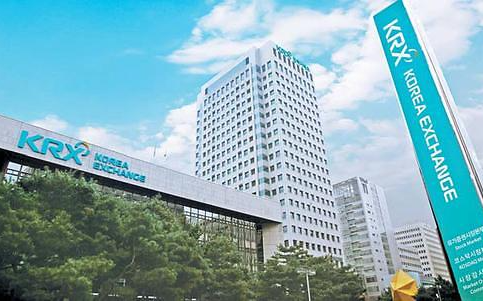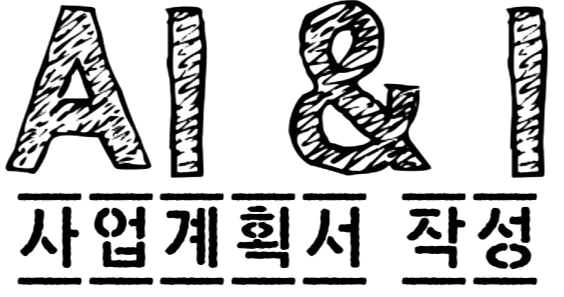1887: The first corporation in Korea, Hansung Bank
1932: Establishment of the Chosun Securities Company
1956: Birth of the Korea (Daehan) Stock Exchange
1961: Securities Crisis
1963: Establishment of the Korea Securities Exchange
1979: Opening of the Yeouido Exchange Era
1996: Establishment of KOSDAQ
2001: Launch of Korea ENC Securities OTC Electronic Trading Market
2005: Launch of the Korea Securities Futures Exchange integrating KSE, KOSDAQ and KOFEX
2009: Name change to Korea Exchange (KRX)
2013: Opening of the KONEX Market (Korea New Exchange) for small and medium enterprises
During the Joseon Dynasty, there were no corporations or stock markets as known today, but the concept of joint-stock companies was first introduced to Korea in the 1880s by enlightenment figures like Yu Gil-jun and Kim Ok-gyun. Notably, in his 1883 article “On Companies” published in Hansung Sunbo, Kim Ok-gyun explained how the West had become wealthier than Joseon and Qing China thanks to the corporate system, based on his understanding of Western capitalism. Although Joseon had large landlords and merchants, the inseparable ownership and capital structure limited growth. Kim Ok-gyun advocated for the introduction of joint-stock companies to establish railway, shipping, and land improvement companies, educating on how to raise and trade stocks. Subsequently, various joint-stock companies began to be established in Joseon.
“In Western countries nowadays, there is no nation that does not encourage commerce by establishing companies, which forms the foundation of a country’s prosperity.”
The Birth of Corporations and the Emergence of Exchanges
The first corporation in Korea is considered to be Hansung Bank (the predecessor to Joheung Bank), established in 1897. Some scholars argue that the first corporation could be the Great Korean Hemp Spinning Company or Cheonil Bank which was founded in 1986, predating Hansung Bank.
Despite controversies, Hansung Bank, which received its corporate license in 1897, is recorded by the Korea Guinness Association in 1995 as Korea’s first corporation. Subsequently, well-known institutions like Hansung Agricultural and Industrial Bank in 1906 and Dongyang Cheoksi Company in 1908 were established.
With the birth of corporations, a market for trading was needed. Following demands to create a stock trading market in Gyeongseong after the Incheon Securities Office in 1896, the Japanese Government-General of Korea authorized the opening of the “Gyeongseong Spot Securities Exchange Market” in 1920. Incheon Securities Office and Gyeongseong Securities Office merged in 1932 to reincarnate as the Chosun Securities Company. However, most companies traded at the time were established by Japanese. Among the brokerage firms, Geumik Securities founded in 1933 and Dong-A Securities in 1934 were owned by Koreans.
The launch of the Chosun Securities Company marked the proper establishment of a securities trading system. The regulations enacted at the time, including transaction methods, market price determination, and prohibition of false trading, aimed at ensuring market stability and fairness.
The First Stock Exchange in Korea: Daehan Securities Exchange
1945: Closure of the Chosun Securities Company following liberation
1947: Issuance of the first lottery, the Olympic Support Ticket
1949: Establishment of Daehan Securities Co., Ltd. under the first license issued by the Ministry of Finance
1950: Issuance of National Foundation Bonds, Land Price Securities
1953: Foundation of the Korea Securities Dealers Association
1954: Issuance of Industrial Revival Bonds
1956: Establishment of the Korea Stock Exchange
In 1945, Korea was liberated following Japan’s defeat. Subsequently, the U.S. military government issued Military Order No. 43, closing down the stock market, thereby halting securities trading for a time. Though the exchange disappeared, stock trading continued informally around Myeongdong due to individuals possessing listed stocks from the Chosun Securities Company of the Japanese colonial era.
Given this demand, efforts to rebuild the securities market began, centered around individuals who had worked in the securities industry before liberation. In 1947, about 40 individuals from the securities and financial sectors, along with related professionals, formed the “Securities Club.” This group led to the establishment of Daehan Securities Co., Ltd., the predecessor of Kyobo Securities, in November 1949 with the first securities business license. Thus, securities trading, which had been halted since the dissolution of the Chosun Securities Company, was resumed through licensed brokerage firms.
Following Daehan Securities, the Korea Securities Company received its license in August 1952, and by 1953, Yeongnam Securities Co., Ltd., International Securities Co., Ltd., and Oriental Securities Co., Ltd., were successively officially authorized. These five securities companies were actively conducting business in Seoul and Busan until the Securities Dealers Association was established in October 1953. In March 1956, the Daehan Stock Exchange was finally established to procure investment funds for post-war reconstruction and economic revival.
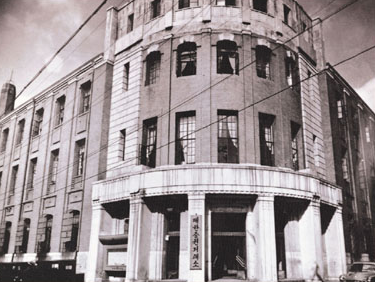
The companies listed on this exchange were limited to 12, and the securities traded were mostly bonds since the stock distribution had not yet occurred. At that time, securities were synonymous with national bonds, making the Korea Stock Exchange predominantly a market for trading government and public bonds, centered around the National Bonds.
- 조흥은행 – Choheung Bank
- 상업은행 – Commercial Bank
- 저축은행 – Savings Bank
- 흥업은행 – Heungup Bank
- 대한해운공사 – Korea Maritime Corporation
- 대한조선공사 – Korea Shipbuilding Corporation
- 경성전기 – Gyeongseong Electric
- 남선전기 – Namsun Electric
- 조선운수 – Chosun Transport
- 경성방직 – Gyeongseong Textiles
- 대한증권거래소 – Daehan Securities Exchange (KRX)
- 한국연합증권 – HanKock United Securites Finance
Securities Crisis
At the time, business owners were skeptical about listing their companies, and the public associated stock trading with gambling, leading to a poor perception of the securities trade. This led to the securities crisis in 1961, caused by stock price manipulation, pushing back the development of the country’s stock market.
At the securities exchange located in Myeongdong, there were only 12 listed stocks, and the market was dominated by just three stocks: Daehan(Stock Exchange), Hankock Stocks (Securities Finance), and Hanjeon Stocks (Korea Electric Power), accounting for 93% of the total trading volume. Among the initial 12 companies, Kyungsung Electric and Namsun Electric merged to become Korea Electric Power Corporation. Despite the challenging environment, Myeongdong was bustling with the enthusiasm of investors.
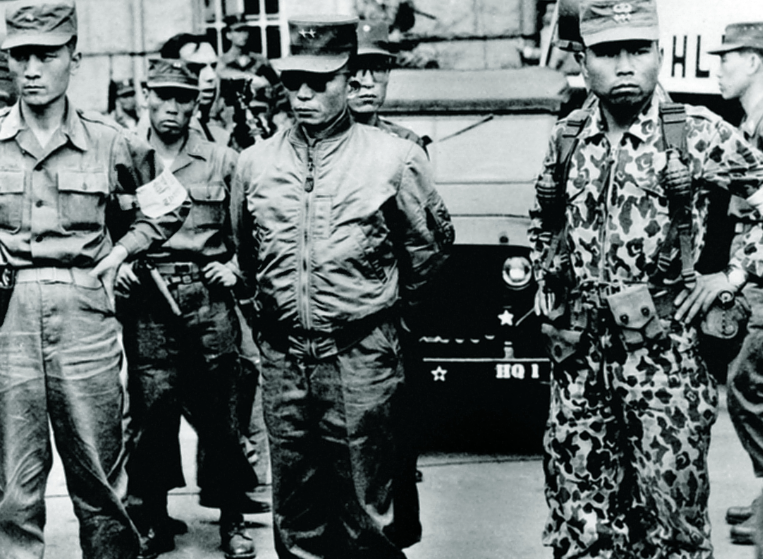
In the atmosphere following the May 16 Military Coup, the Park Chung-hee military government effectively took control of the executive and legislative branches through the Supreme Council for National Reconstruction, yet faced the challenge of transferring power to civilian rule. Funds were needed for elections. The Korean Central Intelligence Agency stepped in, buying shares of Korea Electric Power Corporation (KEPCO) to raise its stock price and profiting immensely. The KCIA established three securities companies under civilian names—Unification Securities, Ilheung Securities, and Dongmyeong Securities—and purchased nearly 70% of Korea Stock Exchange shares. This was followed by the Park Chung-hee government’s announcement to actively promote the securities market to finance the Five-Year Economic Development Plan. Korea Stock Exchange shares, which were trading at 5 jeon each, skyrocketed to 21 hwan and 10 jeon by April 18, 1962.
However, just as bubbles are prone to burst, there were investors suspicious of the tremendous surge in stock prices at the time. When one or two people began to sell their shares, a flood of sell orders followed, causing stock prices to plummet and eventually leading to a crisis. Amidst plummeting market confidence, the stock market entered an unprecedented indefinite suspension on February 26, 1963. The market reopened on May 8, leaving a record of 73 days of closure. This securities crisis led to a widespread social perception that the stock market was increasingly unstable.
Capital Market Development
1963: Dissolution of the Korea Stock Exchange Corporation and establishment of the Korea Securities Exchange, a non-profit special corporation
1963: Issuance of South Korea’s first convertible bonds
1968: Implementation of the ‘Capital Market Promotion Act’
1972: Dong-A Pharmaceutical’s issuance of the first unsecured corporate bonds
1974: Establishment of the Korea Securities Depository (predecessor of Korea Securities Depository) 1976: Introduction of unified standard securities regulations
1979: Beginning of the Yeouido era in Yeongdeungpo-gu, Seoul
To restore the credibility of the plummeted stock exchange and protect investors, the government reorganized it into the publicly funded Korea Securities Exchange in May 1963. The capital at the time was 3 billion won, with the government contributing 68% and securities firms 32%.
In 1968, the Capital Market Promotion Law was enacted to actively encourage public offerings, marking the start of South Korea’s economic development, notably during the Vietnam War in the 60s and Middle East construction booms in the 70s. By 1968, the number of listed companies increased to 34, and by the 1970s, the number surpassed three digits.
However, this expansion of the stock market brought another bubble. During the time when construction stocks dominated the market due to the Middle East construction boom, people started buying stocks simply because they were construction stocks. This speculative trading atmosphere began to transform into an investment market with the adoption of ordinary transaction systems, abolishing clearing transactions in 1971. In July 1979, a new building was constructed and moved to Yeouido-dong, Yeongdeungpo-gu, Seoul.
Securities Popularization and the Launch of the KOSDAQ Market
The 1980s marked the beginning of economic expansion centered on exports, fueled by the “three lows” boon: low exchange rates, low-interest rates, and low oil prices. This benefited the price competitiveness of export companies.
1981: Issuance of foreign exchange funds for foreigners
1984: Launch of the Korea Fund in the USA
1985: First issuance of overseas convertible bonds (Samsung Electronics)
1988: First issuance of national stocks (POSCO)
1989: Issuance of the first domestic exchangeable bonds (Sunkyong) and overseas rights offering bonds (Sammi Special Steel)
1990: Samsung C&T’s first issuance of overseas depository receipts (DR) in South Korea 1993: World’s first issuance of global bonds (Korea Electric Power Corporation)
1994: Listings of POSCO and Korea Electric Power Corporation on the New York Stock Exchange
1995: Launch of the stock index futures market
1996: Opening of the KOSDAQ stock market
1997: Request for IMF bailout 1998: Introduction of advanced financial products such as asset-backed securities (ABS)
Stock Market Liberalization
With the growth of the Korean economy, interest in the Korean stock market from foreigners increased. At the time, foreigners could not directly own Korean stocks but could invest through portfolios mixed with bonds and stocks named foreign exchange funds. In 1981, gradual measures for the liberalization of domestic capital markets were announced to attract foreign capital for indirect investment in the domestic securities market.
In 1984, as part of capital market liberalization measures, Daewoo Securities Co., Ltd., and Scudder, Stevens & Clark (SSC) jointly created the Korea Fund on May 14. The Korea Fund, similar to foreign exchange securities in being an indirect investment for foreigners, differed in that it was a separate corporation that could buy and sell in the domestic market. The trust period for foreign exchange securities was set for 20 years or indefinitely, aiming for long-term investment with almost no prospect of rapid capital outflow.
Foreigners began buying and selling stocks directly on the Korean stock market starting from January 1992. Since then, South Korea’s investment culture has evolved, introducing new terms and investment strategies such as the “low PER revolution,” “blue chips,” and “mergers and acquisitions (M&A),” leading the stock market.
The KOSDAQ Market Establishment
On July 1, 1996, the KOSDAQ market was established by the Korea Securities Dealers Association and securities firms through KOSDAQ Securities Market, Inc. The creation of KOSDAQ aimed to facilitate easier fundraising for small and medium enterprises (SMEs) and venture companies. It opened a new pathway for SMEs and emerging venture companies to raise funds in the stock market.
Initially, the KOSDAQ market struggled to gain investors’ trust, with its trading volume barely reaching the equivalent of 1-2 days of trading at the Stock Exchange for a year. The situation worsened following the 1997 Asian Financial Crisis, leading to a further slump, with the KOSDAQ index hitting 60.7 in October 1998.
The turning point for the KOSDAQ market came with the IT venture boom in 1999. For instance, Saerom Technology’s stock price soared from 2,575 won in August 1999 to 308,000 won by February 2000, an increase of nearly 120 times. Daum saw its stock price rise from 11,200 won in November 1999 to 406,500 won within just two months, a 36-fold increase. Although this bubble, similar to the dot-com bubble in the U.S., eventually burst in 2000, it significantly contributed to attracting many investors to KOSDAQ.
The Advent of the Equity Fund Market
2001: Opening of KoreaENC Securities over-the-counter electronic trading market
2002: Establishment of the Stock Exchange’s stock options market and Exchange-Traded Fund (ETF) market
2004: Enactment of the ‘Indirect Investment Asset Management Business Act’ and activation of indirect investments (funds)
2005: Launch of the Korea Exchange (a consolidated exchange combining the Korea Stock Exchange, Korea Futures Exchange, and KOSDAQ Securities Market)
2007: Stock market capitalization exceeds 1,000 trillion won, KOSPI surpasses 2,000 points
2008: Global financial crisis triggered by the U.S. 2009: Enactment of the ‘Capital Market and Financial Investment Business Act’ (consolidating capital market-related laws)
2010: Record number of IPOs (96 companies)
2011: Rapid expansion of the ETF market (4th largest in the world)
2012: Samsung Electronics’ market capitalization surpasses 200 trillion won
2013: Opening of the Korea New Exchange (KONEX), a market dedicated to SMEs
2023: Abolition of the foreign registration system
Since the late 1990s, a venture company investment trend ignited a KOSDAQ investment frenzy. However, as the bubble began to deflate in 2000, it left many individual investors deeply scarred. The global environment was also unfriendly, with the ‘9/11 terrorist attacks’ in 2001 further chilling the already bubble-burst U.S. investors’ sentiment. The situation worsened with the accounting fraud scandal of Enron by the end of 2001, increasing investors’ anxiety and concerns about economic recession.
Despite such circumstances, the Korean stock market entered a major bullish period from 2003. An investment boom in installment savings funds led to an influx of personal funds into the stock market, with funds serving as a solid support against foreign investors’ selling pressures. The stock index surpassed the 1,500-point mark in April 2007 and broke through the 2,000-point barrier in October of the same year.
In 2007, the U.S. subprime mortgage crisis followed by the global financial crisis in 2008 hit the world hard, marking the bankruptcy of Lehman Brothers, a leading hedge fund and investment bank. This crisis led to a global shift in funds towards ETFs, with South Korea’s ETF market starting to grow from 2011. The domestic ETF market, established in 2002, experienced rapid growth, averaging about 40% annually and becoming the 4th largest market in the world by 2011.
With the general stock market entering a major bullish phase, the South Korean stock market has become an undeniable major market. Samsung Electronics was valued at 100 trillion won for the first time on January 4, 2006, and its stock exceeded 200 trillion won by 2012.
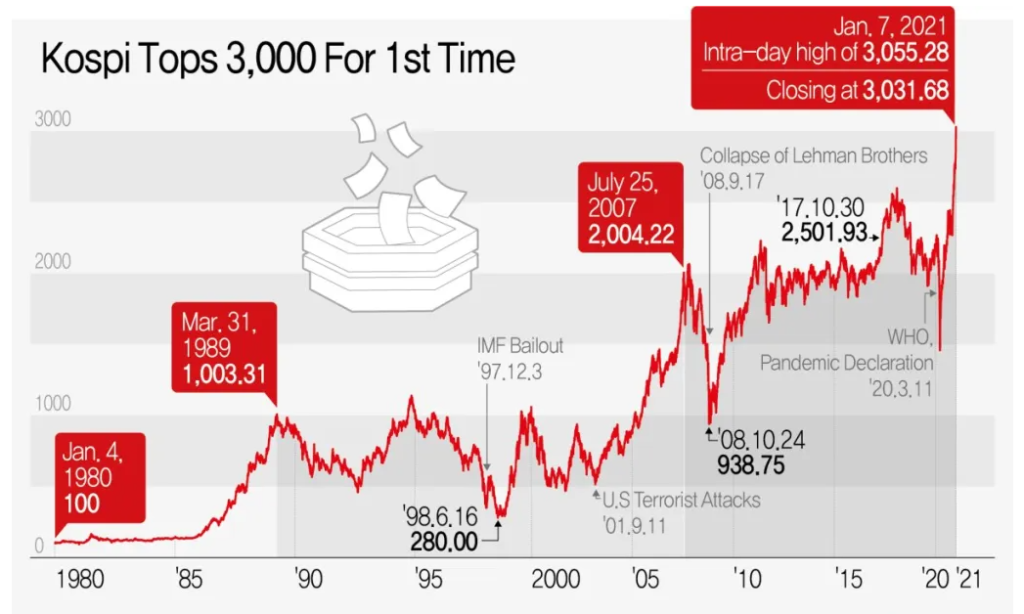
The comprehensive stock price index was introduced to Korea in 1964, but the index we need to compare today began on January 4, 1983. In 1972, as the stock issuance market began to grow significantly, the Korea Composite Stock Price Index (KOSPI) was first announced with the same name. However, in 1983, the calculation method was changed from the previous Dow Jones style to the current market capitalization method. This was due to both qualitative and quantitative growth in our country’s securities market, which highlighted issues with the old Dow Jones calculation method, and a global trend towards market capitalization indexes.
KOSPI had a strong start from January 4, 1983, with 100 points as its basis. On the same day, KOSPI closed at 122.52 points, reached 1,000 points on March 31, 1989, closed at 2,000 points on July 25, 2007, and for the first time on January 6, 2021, it broke through 3,000 points during trading. This milestone was achieved 38 years after the launch of KOSPI.

